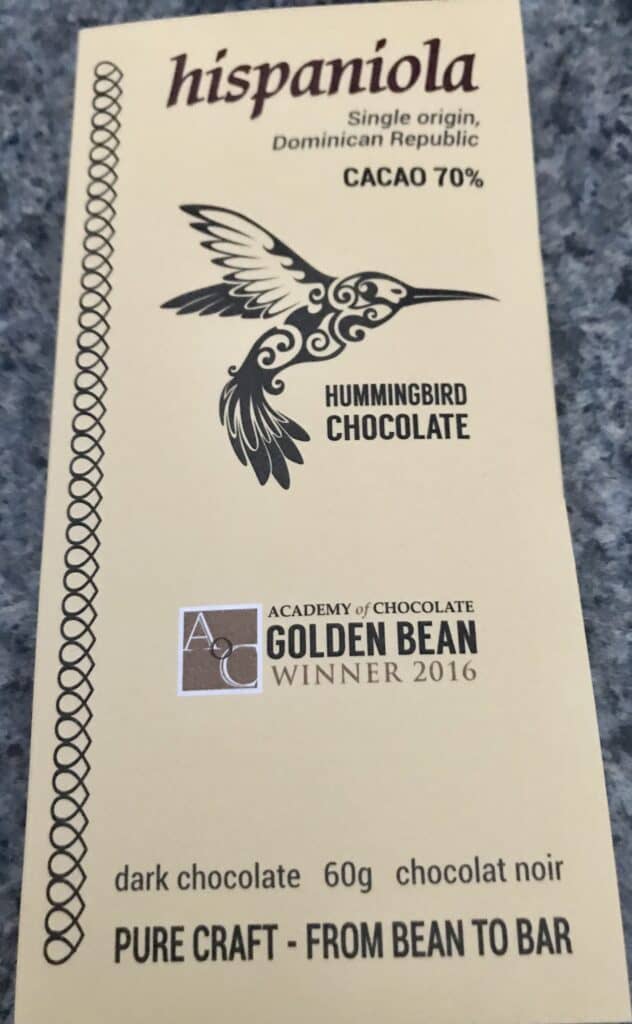
If you love the Caribbean, you’ve likely been to the island of Hispaniola–home to the Dominican Republic and Haiti. Both countries grow award-winning cacao that has been crafted into award-winning artisanal chocolate by multi-award winning chocolate makers like Hummingbird Chocolate of Almonte, Ontario, Canada.
As a discerning chocolate lover, you can help one of the best destinations for the production of top grade cacao in their time of need. The Dominican Republic was hit by hurricane Fiona and the farmers there are still in need of your help to recover. Follow this link to help cacao growers in the Caribbean’s top producer of fine grade cacao.
Lovers of fine artisanal chocolate should know that the Dominican Republic (DR) is the largest producer of cocoa in the Caribbean. The largest producers worldwide are the Ivory Coast (West Africa), followed by Brazil (South America) and Ghana (West Africa).
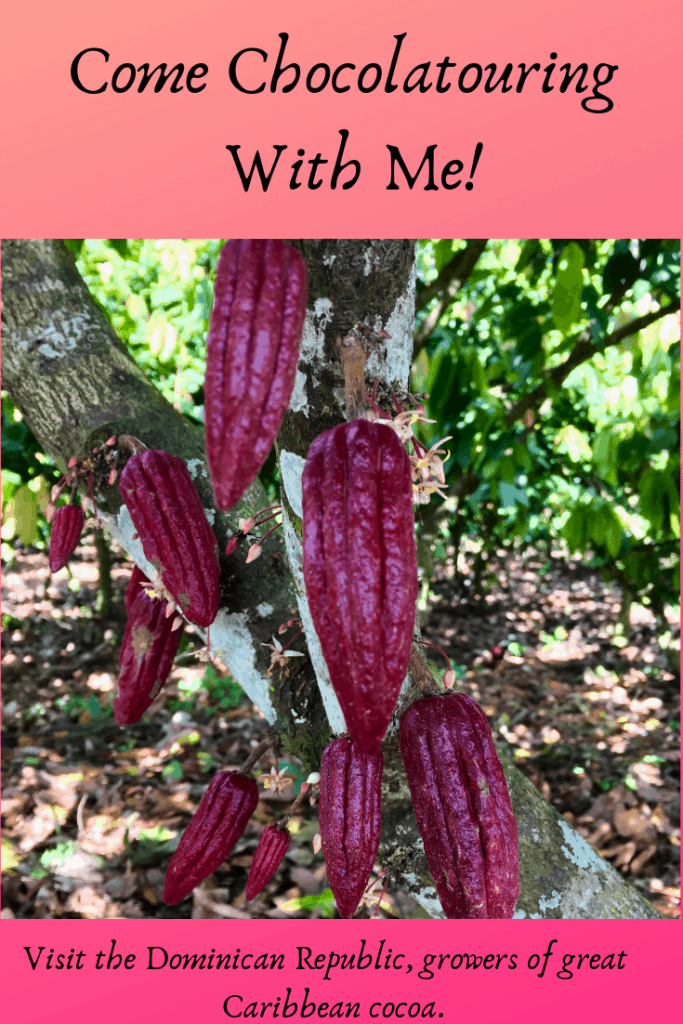
growing sustainable cocoa in the dominican republic is focused on organics
The really interesting thing is that as small as it is, the Dominican Republic is the largest producer of organic sustainable cocoa in the world, offering up 70,000 tonnes of high-grade, organic, fine-flavour cocoa for export each year. That explains why so many of the world’s finest chocolate makers love working with cocoa beans grown in the Dominican Republic. It is delicious, sustainable, and organic!
In 2015, the Government of the Dominican Republic, the National Cocoa Commission (NCC), and the United Nations Development Program signed an agreement to strengthen the sustainability of the cocoa sector that directly employs 40,000 farmers and provides employment to an additional 350,000 of the island’s population. The goal is to bring cocoa up to the number two spot after sugar cane, which remains the top agricultural crop of the DR. Cocoa is currently a close second to tobacco, but officials feel it has strong growth potential and continue to work with cocoa farmers to help them succeed.
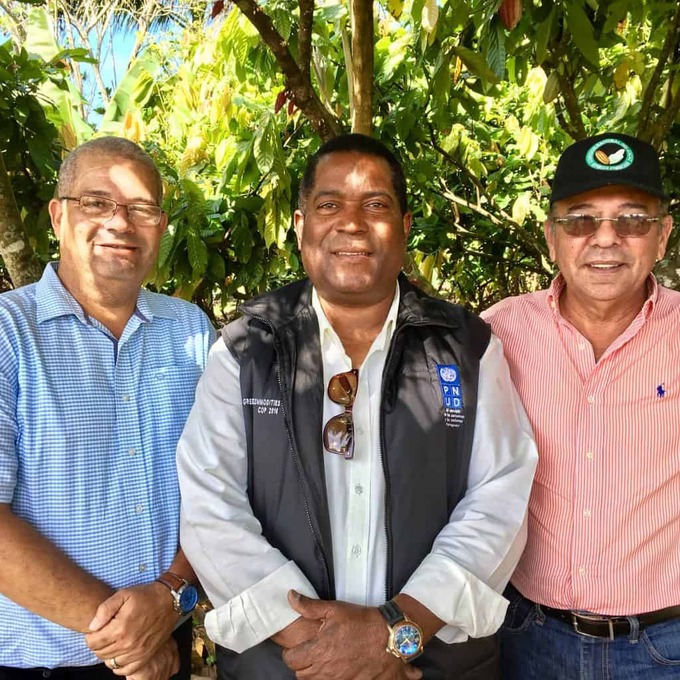
I visited the National Cocoa Commission (Comisión Nacional Del Cacao) and learned much from its representatives. The purpose of the NCC is to preserve the genetics of Dominican Republic cacao, and to sell cacao seedlings to cocoa farmers. The primary type of cacao grown in the Hato Mayor region of the DR is a Trinitario hybrid that has been created by grafting Amelonado with Criollo. This was the first time I had ever heard of Amelonado cacao. Its beans are highly aromatic and produce cocoa with an intense floral flavour.
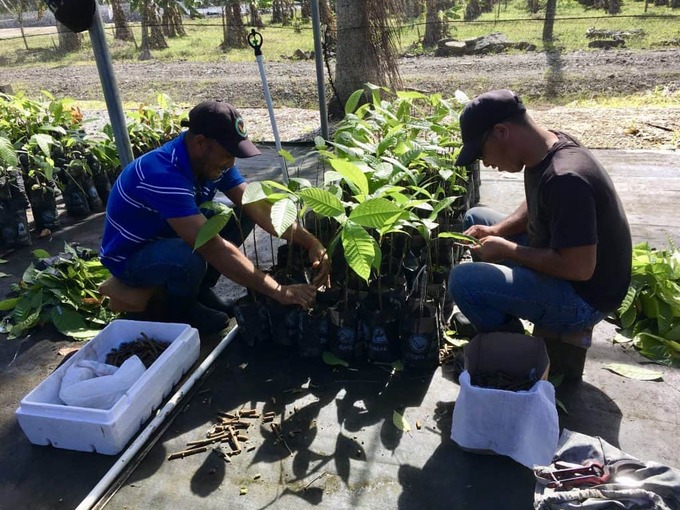
Because, for the most part, the climate of the DR is perfect for growing cocoa, the island has had good success in producing a high-grade organic product that is highly coveted around the world by chocolate makers and chocolate lovers alike. “The Dominican Republic is paradise for cocoa, as it has very little disease, and no problem with insects or vermin,” said Yony Molina Soto, a Farmer Education Specialist with the NCC.
The DR has virtually no Black Pod Disease that you see in so many of the cacao growing countries. It was particularly bad in Ecuador during my visit. There have been problems with rats and woodpeckers, but the farmers have come up with solutions. They put out coconut mixed with salt, and it kills any rats who eat it. And they’ve had success with scaring woodpeckers away by hanging plastic bags in the trees. Persistent woodpeckers are shot without a trial.
It has been determined that the cocoa farmers need more training in their fermentation and drying practices to produce an even better product, and allow the farmers to charge more for their product. Once the improved farming and processing techniques have been fully put into place, the DR will be well on its way to truly having a sustainable value chain for all involved in the cacao industry.
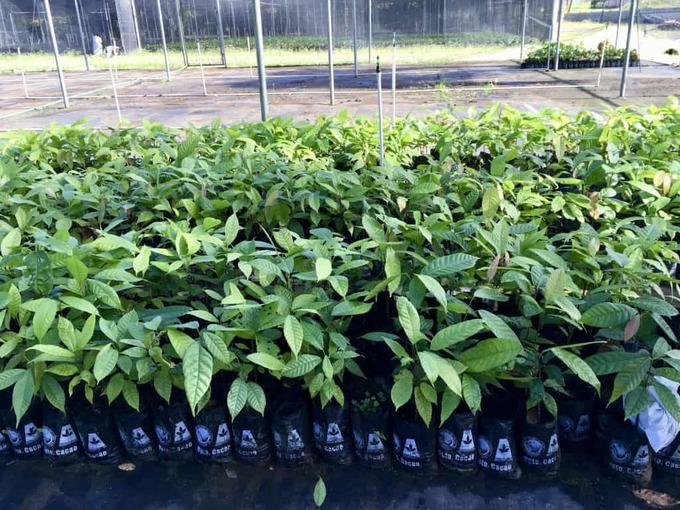
Improvements to the infrastructure are also necessary. As I mentioned in this post about the El Seibo women’s cocoa cooperative, the rains often wash out the local roads, thereby delaying transportation of the fresh cocoa beans to the fermenting stations in a timely manner.
At present, the NCC has 10 full-time staff working at its Hato Mayor farm location, with its headquarters in the capital of Santo Domingo. There are plans to build a lab and chocolate workshop on the rural site among the 2,000 fully grown cacao trees and the 400,000 seedlings they have planted. The commitment to cacao is very strong throughout the Dominican Republic–all the way up to the President’s office, I am told.
As mentioned in the beginning of this post, the Dominican Republic has been hit yet again by devastating loss due to hurricane. Please help the cacao producers of the DR by donating to their GoFundMe campaign.

Yes Doreen… know them well. The name spagnvola was my initial contribution and that name is based on 15th century Italian for Hispaniola. See also_Askanya Chocolate from Ouanaminthe Haiti..
I have chosen a different route. I have been trying to produce the “finest Dominican beans possible” by documenting terroir and other variables y more. I am close.
The bean, the story behind the beans, the campesinos who are most knowledgeable and the most exploited are the núcleos of chocolate. To know that fact is to love that _ bean = chocolate.
Thanks for this comment, Myrvin. I am truly interested in your story and the research you are doing. You are most welcome to e-mail me directly via the Contact page if you have further information to discuss. Yes, I had amazing chocolate from Haiti made by Hummingbird Chocolate of Canada. You will find them profiled on this site.
Hi Doreen:
I am a retired, a cacao and coffee farmer in the mountains within the “falda” of the Natiional Park Los Haitises. After a stressful Architect career in New York, I am blessed to be a member of the chocolate mass.
The opportunities are endless, the journey very difficult but the results aré estupendos if and when achieved. I am now organizing a local Cooperative to better the values and cash flow of compesinosin the Eastern Region of the Dominican Republic..stationed in Hato Mayor del Rey.
Welcome to the DR and I can be and would like to be your chocolate guru here in the DR. This, my final assault on living the good, sweet and chocolaty life.
Very cool, Myrvin. Thx for making contact. Do you know Eric and Crisoire Reid? All the best to you in your new world.
Hi Marvin, I am exploring to start a cacao farm in DR and your post was interesting. I am a retired Doc and am curious as to your journey with cacao farming if you wouldn’t mind sharing. Thanks in advance
Hi Doreen,
where can someone find farming information about Cocoa? I have looked online but haven’t had much luck. My husband and I currently own land in the Dominican Republic and would like to start a cocoa farm Any information would be much appreciated.
Hello Ebony and thank you for your comment. I would definitely recommend that you contact the National Cocoa Commission (Comisión Nacional Del Cacao) as they have cacao seedlings that farmers can purchase, and they can help guide you in this endeavour. Good luck to you!
First a fall brilliantly written article, it extends more than just about chocolate. How cacoa growing, production can give employment to farmers and so many other people, that’s great. Nice cacoa = better chocolate and even coffee. So many population consumes coffee, next of course comes chocolate.
I really am intrigued to know rats can be killed by feeding them coconut mixed with salt…
Nowadays, when I buy chocolate I see the percentage of cacoa in it, mostly dark chocolates. They priced higher but for the flavour worth a buy. I have to see how white and milk chocolates go but I like dark chocorates with cranberry flavour, buy it as a treat once a while. They come in big bars not small but I buy it and eat it all slowly at once. Sometimes I like eating and doing nothing…
It would be good if they have a cacoa exbibition like they have wine, it’s pretty interesting as cacoa has en varieties too and people don’t appreacite it and as coffee and chocolate consumers they need to know about cacoa beans!!
I like dark chocolate and cranberries, too, Stefinia. Thanks for your response to my post. I am indeed on a mission to educate, entertain, and entice chocolate lovers to travel the world for chocolate.
Organic cocoa sounds really good and even more interesting. Glad that positive initiatives are being taken here for the betterment of the community. I would love to try some chocolates made out of this cocoa.
Interesting that it has none of those common diseases. I am glad that the authorities here are taking some positive steps to make it better with the farmers. I love the way you share the stories behind my favorite food 🙂
Thx so much, Ami. I do find the story behind chocolate and my other fav foods and libations makes the consumption so much more meaningful.
Ooh that color is amazing, glad you shared the image with us! Never knew about it!
Love absorbing information like a sponge 😀
I had no idea about this..Glad to have come across your detailed post!
It is always interesting to read about cacao farmers. Modern living allows us to overlook where our food comes from. But it is a nice reminder that what we eat often involves hard work, sacrifice and a lot of passion.
So true, Erica. It makes eating so much more meaningful when we know the history and origin of our food.
Its’ a mesmerizing post, always fascinated by cocoa. You have given such great details which explain the greatness of cocoa. The remedy for the rat menace is interesting too.
Thx, Sandy. I’m so glad you are finding my posts engaging.
I am always fascinated about all the information to find on chocolate; so interesting!! Wonderful to read it’s helping the people of the Dominican Republic!
I would like to know more about preserving the genetics of Dominican Republic cacao. People do not realize, many regional types farming plants are going extinct. Bigger companies are buying farms, then planting the one crop which has the highest profit margin. This has happened with corn, now it is nothing but a version with a higher sugar level. Also in California, they are buying grape farms, removing them and replacing them with a version to make a sweeter wine.
HI William and thx for your interest on the topic of cacao genetics. I plan to research this subject further when I visit the World Cocoa Foundation later this year.
Rats are sometimes also a problem in residences of my hometown. If coconut mixed with salt can kill them then that would be excellent! It is good to know cacao produced in DR doesn’t have those terrible diseases, so they must be very healthy to eat!
Hi Tania and thx for your comment. I do find it quite ingenious how farmers in various regions find ways to cope with the pests who challenge the growth of their beloved cocoa.
It sounds like the cocoa farming industry in DR is strong, and will continue to grow even stronger. It will be great to see how well it goes once the farmers are trained to better their products, and of course the roads are fixed as well.
Hi Emily. It is indeed encouraging to see how farmers in the DR are growing thru cocoa. Continuing education and an improved infrastructure are key.
Seventy thousand tons is a lot of cocoa! Too often, we don’t think about where our food comes from, no matter what kind of food it is. I used some cocoa this weekend for a chocolate Dutch baby, and it never crossed my mind where it was sourced from.
Hi Jeri. I do find it interesting where our food comes. And cacao is the food of the gods!
What an interesting post. I didn’t know that is how cocoa is produced. 4,00,000 seedling is a big number. Seems like the economy of Dominican Republic revolves around cocoa. I would like to taste it!
Thank you for your comment, Abhinav. I’m quite sure you would enjoy chocolate made from Dominican cocoa. It is delicious!
Who would have known (apart from you) that Dominican Republic produced the largest number of cocoa? Thank you for providing us with facts as well as causing us to dribble over your many photographs of chocolate. You certainly know your countries – a walking Geography Teacher.
So interesting Doreen, and like some others here I was surprised about the color of the cocoa. Such fascinating work you do, and all the great people you get to meet!
Hi Marty. I feel truly blessed to be doing the work I am doing. Being immersed in the world if chocolate is a delicious place to be!
When I was there on a voluntourism program in January I went to a women’s chocolate cooperative. We helped plant seedlings. But no one told us how big this industry is in the country. It’s great to learn the DR getting a boost to their economy through cocoa.
Hi Suzanne. I believe cocoa offers a bright future to the DR. Hopefully, it will continue to grow and prosper.
I love the Cocao seedlings! The foliage is so bright and bold. I wonder if they could be purchased somehow here in Canada, like the fig tree I purchased a year ago, just to see how they grow as a unique potted plant. Maybe it could even be some kind of fundraiser with proceeds from the sales going directly back to the cocoa farmers. Of course, I wouldn’t want to leave it on my deck in case it was beset by the woodpecker that roosts in my backyard….
I too love the vivid red pods! Mother Nature sure has a quirky sense of humour and style.
Hi Renee. That is a unique idea about trying to grow or sell cacao seedlings!
With respect to growing them, I do believe one could easily enough sprout the daw cacao beans in a fresh ca so pod. I just may try that the next time I bring one back from the tropics!
With respect to successfully growing them outdoors in the ground, I believe the most northerly region that has done this is Miami, Florida.
Very interesting post! Is the Dominican cacao particularly good because of the variety that is grown or because of something in the soil or because of how it is processed?
Hi Rachel and thanks for your curiosity. It’s a blend of all of the above. Dominican Republic chocolate is primarily great because of the unique variety grown. I’d never encountered that specific blend before. The soil/terroir factor certainly comes into play in setting the flavour notes. Some unique processing parameters to coincide with the local climate will also factor in. And that is the recipe for perfect chocolate!
Agree with Leni and Donna that the red pods are beautiful and also about rooting for the farmeres of the Dominican Republic.
Like Leni, I’m rooting for the farmers of the Dominican Republic. I love the picture of the red pods at the front of the post – so pretty.
They are, aren’t they, Donna? I love the fact that cacao pods come in so many rich colours. So beautiful!
This is great, Doreen. I bought some of the cooperative DR chocolate last summer when I visited on the Fathom cruise. The chocolate had an odd taste to me. It was probably because it was high quality and natural. 😀
Hi Charles. It is indeed very critical how the cocoa is processed and made into chocolate that will affect the ultimate flavour. I’m not sure if you’ve eaten much dark chocolate. It certainly has way less sugar than the chocolate candy we grew up on! I encourage you to try SPAGnVOLA chocolate, readily available in the US, but fully grown and processed in the DR.
I had no idea cocoa employed so many people in the DR! Fantastic that organic production is doing so well. Interesting too that coconut mixed with salt kills rats.
Hi Michele. Yes, I had no idea how many people in the DR are involved in the cocoa and chocolate industry! I’m glad to see that cocoa is winning out over tobacco.
Doreen, this was a fascinating post. I’m rooting for the cocoa farmers of the Dominican Republic – what an amazing amount of jobs they create, direct and indirect.
It’s funny about woodpeckers. There they are a nuisance yet here every night at supper time I get a lot of pleasure watching two woodpeckers hopping up and down our maple tree. 🙂
I agree, Lenie. The woodpeckers sure can be fun to watch. But they can also be very devastating to the wood on a tree, or in some cases, may peck at the pods and ruin them. This is the first country where I’ve heard about woodpeckers being a pest with cacao. I will have to research to see which species of woodpecker they get in the DR. We get the giant pileated woodpeckers here on the Prairies, in addition to a few others smaller species.
Doreen, we have only once seen a large pileated woodpecker here and we stopped what we were doing to admire it.
The ones I watch are the downy woodpeckers – so cute – they kind of bounce up the side of the tree.
Hi Doreen, I had no idea that cocoa pods grew in that color! Must be something in the soil…? Glad to know the organic market is having such success.
Hi Esther and thanks so much for your comment. Different varieties of cocoa ripen in different colours. They can be red, orange, yellow, purple, or a combination thereof! The pods pictured in the post sure are a beautiful shade, aren’t they?